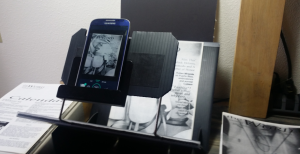The narrative in the U.S. press has been that Donald Trump, arguably the most divisive major party candidate for President in American history, can’t win the general election. How does someone win the Presidency when the story in the polls says that he’s going to lose every major demographic group except white males?
Until the last week, the only question appeared to be “how big will Hillary Clinton’s victory be?” Now, suddenly, polls that have the two head-to-head. Even with the latest polls, Nate Silver, one of the great masters of polls and statistics, still gives Clinton a 2/3rds chance1 to win the Presidency.
But, one chart in the most recent PEW survey2 tells a very different story. If there are two groups most clearly identified with the opposite sides of the American Culture Wars,7 they are white evangelicals (aka the “religious right”) and the religiously unaffiliated (what PEW calls the “nones”).
The Republican party has been explicitly targeting what came to be called the Religious Right3 since before most Americans were born. In parallel, Nixon’s Southern Strategy4 targeted white southerners who rejected changes that were driven by the civil rights movement. There was significant cross-over between those two group and the two appeals effectively merged into the Republican party’s appeal to white evangelical voters.
Overall, it had a large impact on American religion. Significant numbers of American Christians disagreed with the politics that were pulled into their Churches and the resulting ways the interpretation of scripture changed. They felt shut out and tended to move across the aisle and/or out of those churches or church entirely and became part of the “nones” group.
While the Republic Party has increasingly focused on a specific vision of and for America, the Democratic Party has become the party of everyone else. The “nones” group was both drawn to and pulled in by the Democratic Party.
Getting back to ground zero in the American Culture Wars, how do these two groups –white evangelicals and nones– feel about the two major candidates? Pew turned the results of their survey into a graph:

The headline, Trump support among white evangelical voters on par with Romney in 2012; Clinton support among religious ‘nones’ on par with Obama, says nothing has changed. There’s nothing see, it’s all status quo. The obvious conclusion is that Clinton (like Obama) is going to win. But, that’s not what the numbers in the chart actually show. Compared to their predecessors, Trump’s support is five points higher while Clinton’s is one point lower.
Of course, polls have many problems. The biggest one is that opinions don’t vote. People who, like those who are motivated, get to the polls vote. As an aside, that’s basically why most elections tend to favor the views of older voters: older voters have had more time to form their opinions so those opinions tend to be stronger so those voters tend to be more motivated.
The chart doesn’t say anything about age but it does say something about motivation. Looking at the motivated votes (the ones who “strongly support” their candidate), the number of white evangelicals who strongly support Trump is 10 points (roughly 40%) higher. Clinton’s strong support among the non-religiously affiliated is actually ten points (roughly 40%) lower.
While these groups are not identical with the respective parties, they are a useful map of a very strong divide in the U.S. and the country’s party structure. What that motivational factor is telling us is that if the election was held today, Trump would probably win. While, the numbers are far from exact and they don’t account for many things, many of the things the numbers don’t account for will actually amplify his victory.
One significant factor they don’t account for is the white nationalists who believe Trump is wink-wink nod-noding them, that he’s their guy5. In fact, members of this group have probably never felt like their was a candidate who understood them or represented their views. To actually have a say in an election? This group’s motivation to vote is off the proverbial chart.
More broadly, events and the news narrative is going to increase this gap. Clinton continues to be forced to look backwards to address issues like email scandals. Trump continues to get to run with weekly and daily stories –five police dead in Dallas shooting, truck used in attack that kills more than 80 in Nice, France, attempted military coup in Turkey, three police dead in Baton Rouge6— that cater to his strong guy, win at any cost, image.
By November, it’ll be landslide territory, Trump’s party will probably have control of both houses of Congress and the chattering classes are going to sputter what’d we miss, how’d that happen again.
Coda
The study2 notes that the most common reason white evangelical supported Trump was “beating Clinton.” Part of the problem for Clinton is a collapse of alternatives. She, and the Democratic party, don’t really have a coherent alternative vision for the future. Some people used to say there wasn’t any real difference between Republicans and Democrats. It is more accurate to say that Democrats were striving (to steal a Republican line) for a kindler, gentler version of the Republican’s vision.
Both sides of the American political aisle are trapped in the world of neoliberalism and neoconservatism. Neoliberalism, in particular, is the water that most people on both sides of the American political aisle swim in. However, just as the Keynesian approach reached it’s limit in early ’70s and the world shifted to Mises and Hayek, today neoliberalism has reached it’s limits but there is no alternative.
Keynes, Mises and Hayek built their economic theories in the era of manufacturing. While manufacturing still exists, for decades computers and software have driven our world and its economic growth. That post-manufacturing era is now closing. Sales of computers and software have been dropping for years. Technology is fading into the fabric of life with most of the actual horsepower existing out in the cloud, plugged into via throw-away smart phones and tablets. The gadgets we encounter in person are, to a large degree, non-functional without an internet connection because the real magic happens somewhere else out of our reach.
This decoupling is mirrored in the world of business. A chat bot gets people out of traffic tickets and law firms have begun to hire Ross, an IBM artificially intelligent lawyer. Businesses are actually in the process of decoupling profits from human labor and traditional investment.
While the world is entering it’s second new major economic eras after manufacturing, people still largely battle under the banners of the ghosts of Keynes and Hayek. The theories were built around factories when a factory is now a 3D printer that can sit on a desk.
For Clinton, when I say there’s a collapse of alternatives, the problem is that all the policy wonkiness in the world will never speak to people unless there’s a vision to unify it. For Trump, on the other hand, it is actually to his advantage that there is no current intellectual vision upon which to base his appeal. The complaints about problems with his policy ideas, the words coming out of his mouth, the what-evers don’t matter because in a world where all the theories are so out-of-date, there’s nothing to stop him from painting whatever picture he wants.
Notes
1. Nate Silver’s forecast is updated frequently. His forecast is a 66.7% chance of Clinton victory versus a 33.3% of Trump victory as of Friday 15 July 2016 at 15:14pm Mountain. Five Thirty Eight, “Who will win the presidency?”: http://projects.fivethirtyeight.com/2016-election-forecast/
2. Pew Research Center, “Evangelicals Rally to Trump, Religious ‘Nones’ Back Clinton.” (13 July, 2016): http://www.pewforum.org/2016/07/13/evangelicals-rally-to-trump-religious-nones-back-clinton/
3. One short personal account: Brian Zahnd, “The Jesus Revolution” (1 July 2016): http://brianzahnd.com/2016/07/the-jesus-revolution/
4. Volumes have been written on Nixon’s Southern Strategy including, perhaps most famously Alexander Lamis’ 1984 book The Two-Party South, based in part on an interview he conducted with legendary Republican figure, LeeAtwater that can be found embedded in Rick Perlstein’s “Exclusive: Lee Atwater’s Infamous 1981 Interview on the Southern Strategy,” The Nation (13 November 2012).
5. Nicholas Confesore, “For Whites Sensing Decline, Donald Trump Unleashes Words of Resistance”, The New York Times (13 July 2016): http://www.nytimes.com/2016/07/14/us/politics/donald-trump-white-identity.html?partner=rss&emc=rss
6. Four major events that occurred in eight days: a gun man killed 5 police in Dallas, Texas, USA (7 July), a man in Nice, France drove a truck into a Bastille Day celebration (14 July), a portion of the military attempted a coup in Turkey (15 July) and between final edits, three more police shot in Baton Rouge, LA (17 July). Each was notable. To find a US event comparable to the Dallas shooting, one has to go back to the mass evictions of farmers during the American dust bowl. The attack in France is the first major instance of an attack against a soft target (effectively making anything and everywhere a target). Turkey is a member of NATO, acts as major forward base for operations against Islamic State (formerly ISIL) as well as one of the major checkpoints in western minds against Russian aggression ala the invasion of Crimea. Baton Rouge is notable for multiple reasons including the fact that the US flag is flying at half staff around the country because of multiple horrific events. It’s easy to suspect we may be entering a period where the days when the US flag is not at half staff are the notable ones.
7. (American) Culture Wars is a term coined by Professor James Davison Hunter for the conflict between traditionalist/conservative and liberal/progressive views of the meaning of America. Culture Wars: The Struggle to Define America (1991) http://www.jamesdavisonhunter.com/culture-wars.
Note: there are no new citations in the Coda section at this time because I’ll be digging in deeper on everything that would normally be cited in another piece.



